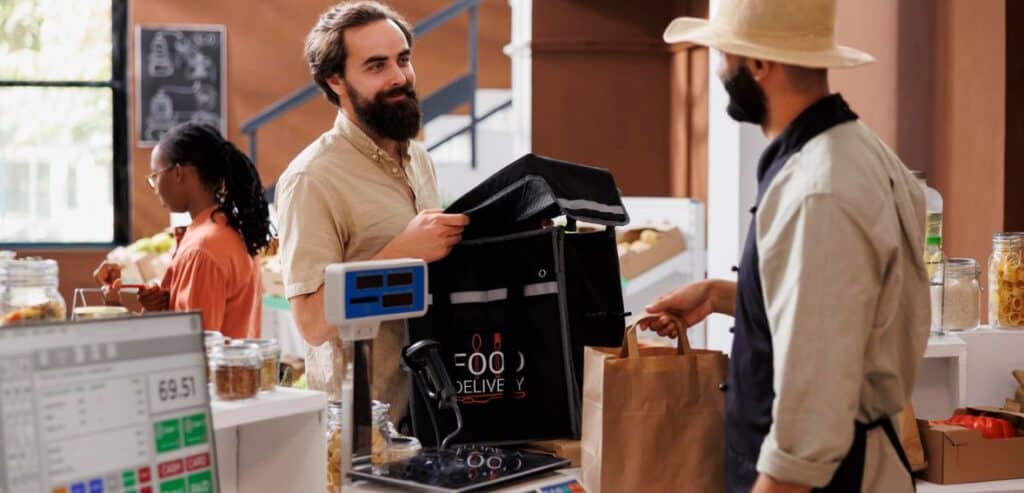
By alphacardprocess September 15, 2025
Thousands of people gather for big events like the Ohio State Fair, where they can enjoy food, entertainment, and unique shopping experiences. This increase in foot traffic offers vendors fantastic opportunities, but only if transactions are seamless and swift. For this reason, mobile terminals and POS setups have become crucial for companies functioning in such demanding settings.
When consumers are prepared to make a purchase, nothing irritates them more than lengthy lines or broken payment systems. For this reason, mobile terminals and fast point-of-sale setups have become crucial for companies functioning in such demanding settings.
With the help of these tools, vendors can instantly process payments, adjust to changing crowds, and increase revenue during constrained event windows. Modern payment solutions are revolutionizing how vendors thrive at fairs and large gatherings by fusing speed, flexibility, and dependability.
The Importance of Seamless Payments at Large Events

Payment systems are one of the most important behind-the-scenes elements at major events like the Ohio State Fair because of the lively atmosphere, heavy foot traffic, and never-ending streams of transactions.
A point-of-sale (POS) system is more than just a device for ringing up goods for vendors, food stalls, ticket booths, and merchandise stands; it is the lifeline that keeps businesses running smoothly under duress. Every year, the Ohio State Fair attracts hundreds of thousands of visitors, and whether a business can handle payments quickly and effectively often determines whether it succeeds or fails during these days of high demand.
Outdated systems, lengthy lines, and network outages can quickly detract from customer satisfaction and lower sales. For this reason, methods for quick POS setups and mobile terminal integration are vital, especially in high-density environments where every minute counts.
Many business owners underestimate how economic nexus laws require them to collect state taxes even without a physical storefront in Ohio. Understanding Ohio sales tax compliance is essential for avoiding penalties and ensuring your tax process is correctly established.
Why the Ohio State Fair Provides a Unique Test Case
Gaining insight from the unique setting of the Ohio State Fair is beneficial. There are countless food vendors, craftspeople, ticket sellers, and entertainment providers at the fair, which lasts for almost two weeks.
To generate income during this critical sales time, a large number of these companies rely on mobile payment systems. Overall success is determined by the ability to set up quickly each day and process transactions with ease.
These vendors work in booths, tents, and outdoor areas, which necessitate portable and flexible systems, in contrast to traditional storefronts. For instance, a lemonade vendor on a hot afternoon cannot afford to waste time waiting for a Wi-Fi connection to stabilize or a slow POS terminal to reboot. Their setup’s effectiveness becomes equally as crucial as the caliber of their output.
Mobile-First POS Solutions as a Practical Answer

Using mobile-first point-of-sale (POS) solutions is one efficient way to handle this environment. These systems, which are frequently app-based, do away with the need for large hardware by turning smartphones or tablets into fully functional cash registers.
They provide speed and portability when paired with lightweight card readers, which are crucial at a gathering like the Ohio State Fair. Vendors are more resilient to possible connectivity outages when they use mobile data networks instead of just local Wi-Fi.
Having an independent system guarantees that payments continue to flow even when Wi-Fi becomes congested, as events frequently put a strain on public networks. Vendors benefit from this flexibility, which guarantees uninterrupted customer service during periods of high crowd surge.
Speed of Deployment as a Decisive Factor
Deployment speed is another crucial factor. Before guests arrive, vendors frequently have a short window of time to set up their booths. Systems that need extensive configurations or difficult installation can quickly turn into liabilities.
For short-term events, quick-start point-of-sale packages are made to reduce setup hassles. Vendors can start up in a matter of minutes thanks to these kits, which usually include plug-and-play terminals, pre-configured software, and mobile network compatibility.
Reducing the technical learning curve will allow employees to concentrate on customer service instead of hardware troubleshooting. Employees who receive pre-event training on user-friendly interfaces experience even less adjustment time and make fewer mistakes when under pressure.
Ensuring Reliability and Redundancy
The foundation of effective event payment systems is dependability, not just speed. Even a small amount of downtime at an event the size of the Ohio State Fair results in lost sales and angry customers. Vendors can implement redundancy measures like enabling offline transaction modes or keeping backup mobile card readers on hand.
Offline processing makes sure that transactions are queued and finished automatically when connectivity is restored, even in the event of temporary network coverage or momentary mistakes. This feature gives high-volume events peace of mind by making sure that any connectivity issues don’t ruin the entire sales flow.
Hardware durability is also a component of reliability. Devices need to be able to endure the harshness of prolonged use, heat, dust, and outdoor conditions. Stability during prolonged fair operations is ensured by investing in durable equipment.
The Impact of Seasonal Events on POS Planning
When taking into account how seasonal events like the Ohio State Fair function, this additional layer of planning becomes even more crucial. Every setup choice is crucial because, unlike permanent retail locations, vendors only have a brief window to capture sales.
There is no time for trial and error, so payment systems need to be operational from the start. Since seasonal businesses frequently depend on these occasions for a sizable amount of their yearly income, downtime or poor performance has consequences that last.
For many, a well-designed point-of-sale system can determine whether the entire season is profitable in addition to improving daily operations. Vendors can maximize every sales opportunity without needless interruption by incorporating proactive and dependable systems.
Meeting Customer Expectations with Modern Payments

The selection of point-of-sale (POS) solutions is further influenced by customer expectations at major events. More and more modern fairgoers plan on using credit cards, debit cards, or mobile wallets in place of cash. If vendors don’t provide these choices, they run the risk of offending clients who don’t have much money.
This need is successfully satisfied by mobile payment terminals that support chip, swipe, and tap-to-pay methods. In addition to speeding up transactions, they also follow general patterns in consumer behavior.
Wait times are greatly reduced by speedy, touchless payments, which are especially crucial when interacting with impatient crowds that are ready to go on to their next activity. A vendor can serve more clients in a given amount of time if the payment process is seamless, which increases the potential for overall revenue.
Balancing Cash and Digital Payments
Even though digital wallets and mobile terminals are becoming more and more popular, cash is still used at big events. Efficiently balancing both payment streams is crucial for vendors. Over-reliance on cash can cause line delays, security threats, and final reconciliation issues.
However, going completely cashless might turn off clients who depend on or prefer cash. Vendors have the flexibility they require when point-of-sale (POS) systems manage both with ease, providing both contactless and speedy cash transactions.
Finding this balance enables companies to prioritize the speed and convenience that mobile-first solutions offer to high-volume event settings while still capturing every sale, regardless of the customer’s preferred method.
Scalability for Larger Vendors at the Fair
For larger vendors handling thousands of transactions daily at the fair, scalability becomes a central concern. Event-ready POS systems that sync across multiple terminals allow businesses to maintain real-time inventory tracking and consolidated reporting.
For example, a large food concessionaire with several stands spread throughout the fairgrounds can benefit from a centralized system that monitors sales and stock levels across all locations simultaneously.
This prevents inventory shortages and ensures consistent service quality, even under intense demand. Real-time reporting also enables managers to make quick decisions, such as reassigning staff or redistributing stock to busier areas of the fair.
The Role of Analytics and Post-Event Reporting

The analytics that event-ready point-of-sale systems offer after the fair is over are among their most overlooked advantages. Vendors frequently focus only on managing large crowds during the event; however, after everything is said and done, the true value lies in understanding sales data.
Reports that monitor inventory turnover, popular payment methods, and peak selling periods provide businesses with useful information for upcoming events. For instance, a vendor can stock more next year if they know that a particular product sells out every day by mid-afternoon.
Additionally, post-event reporting streamlines financial planning and tax preparation, which helps businesses assess profitability. A short-term opportunity can be transformed into long-term business growth by utilizing these insights.
The Role of Payment Processor Partnerships
Partnerships with payment processors constitute an additional strategic layer. Vendors should select service providers who provide clear pricing plans free of unstated costs that could reduce earnings.
Working with providers who have experience supporting seasonal or mobile businesses is essential because events require temporary setups and high-volume bursts. Some processors even offer packages tailored for fairs, festivals, and concerts, specializing in event-based services.
Dedicated customer support teams that are aware of the urgency of event operations are frequently included in these services. Rapid support guarantees that vendors can return online as soon as possible in the event of technical difficulties, reducing downtime.
Keeping Security at the Forefront
Naturally, security is still of utmost importance in any payment environment. Due to high transaction volumes and shared public networks, there is a greater chance of fraud or data breaches during large-scale events. Customer data security is ensured by putting in place PCI-compliant systems and encrypted mobile readers.
Risks are further decreased by training employees on best practices, such as never leaving terminals unattended or unsecured. Customers are becoming more conscious of security issues, and suppliers who can offer secure, easy payment methods win patronage and trust outside of the fairgrounds.
Training Staff for High-Volume Environments
Although technology is essential, its users are just as significant. A point-of-sale system is only as good as the team running it, and stressful situations like the Ohio State Fair can overwhelm inexperienced employees.
The system will function as intended if employees are trained on how to handle various payment methods, process transactions rapidly, and troubleshoot simple problems. Additionally, this preparation lessens stress during busy times when customers may become impatient due to long lines.
Employees who are at ease using mobile terminals and quick point-of-sale setups directly contribute to increased customer satisfaction and faster throughput. Before the event starts, a little more training can help to avoid expensive errors and make everything run more smoothly.
How POS Efficiency Shapes Customer Experience

Lastly, all of these strategies are connected by the customer experience. People go to events like the Ohio State Fair to have fun, not to wait in line or endure annoying payment delays.
Vendors who offer quick, easy, and welcoming checkout processes improve both their reputation and sales. Positive experiences increase the likelihood that many customers will stick with the same suppliers year after year. Effective point-of-sale (POS) strategies thus generate lasting value that surpasses the transient nature of the fair itself.
Conclusion: Turning Payments into an Advantage
With its unique fusion of custom, entertainment, and business, the Ohio State Fair offers a perfect prism through which to view modern payment issues. Fast setup times, mobile compatibility, and smooth payment processes are now essentials for success in high-demand, fast-paced settings.
Vendors can optimize revenue and customer satisfaction by adopting mobile-first point-of-sale (POS) systems, planning for dependability, and giving priority to customer convenience. Vendors who quickly adjust will not only survive but flourish in this new event economy as consumer behavior continues to shift toward digital-first payments.
Methods for integrating mobile terminals and quickly deploying point-of-sale systems at occasions such as the Ohio State Fair emphasize the merging of technology and human experience. Vendors can turn payment processing from a possible hassle into a competitive advantage by highlighting speed, dependability, scalability, and customer-centered service.
In addition to maintaining line flow, the objective is to foster seamless interactions that improve the whole fair experience. By doing this, vendors make sure that the Ohio State Fair continues to be a vibrant marketplace where both companies and consumers can profit from innovation, in addition to being a celebration of culture and community.